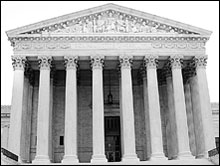 With two conservative justices joining the bench, and swing-vote justice Sandra Day O’Connor now gone, the announced early this week that it will consider the constitutionality of a federal ban on the procedure commonly known as “partial-birth abortion.” The Bush administration, led by Attorney General Alberto Gonzales, has pushed the Supreme Court to review a number of these decisions, and now they’ve gotten their wish.
With two conservative justices joining the bench, and swing-vote justice Sandra Day O’Connor now gone, the announced early this week that it will consider the constitutionality of a federal ban on the procedure commonly known as “partial-birth abortion.” The Bush administration, led by Attorney General Alberto Gonzales, has pushed the Supreme Court to review a number of these decisions, and now they’ve gotten their wish.
The ban, signed by President Bush in November 2003, outlaws a procedure performed when it’s too late for a woman to undergo a medical or vacuum-aspiration abortion (usually after 13 weeks). The wording of the ban is purposefully vague, but those who support it say that it describes the process of “dilation and extraction” (D&X) in which a woman’s cervix is dilated and the fetus is aborted.
Three federal courts, in New York, California, and Nebraska, have already struck down the ban, as have three appellate courts, arguing that its lack of an exception when the mother’s health is on the line renders it unconstitutional. In addition, several courts found the law as written so vague that it could be applied to perfectly safe and otherwise legal procedures outside the intended scope of the ban.
Just six years ago, the high court considered a similar case, Stenberg v. Carhart. With then-justice O’Connor casting the deciding vote, the court struck down the Nebraska state ban on partial-birth abortions on two counts. First, because in some situations D&X may in fact be the safest option for a woman, and therefore necessary to protect her health. Second, the court found that the law reached too broadly into more-common, second-trimester procedures, which would place an unconstitutional undue burden on women seeking abortions.
Both sides are looking to that 2000 ruling as a harbinger of what’s to come this October, when the court will hear oral arguments in the new case, Gonzales v. Carhart.
Clarke Forsythe, an Americans United for Life attorney and one of the architects of the right-wing attempt to chip away at 1973’s Roe v. Wade, is optimistic for several reasons. He hopes that the court will be more likely to uphold this federal law than to preserve Nebraska’s state law. Plus, he thinks there is more supporting evidence in favor of the ban now than there was in 2000.
In its ruling in Gonzales, the court could overturn Stenberg, Forsythe adds, describing that decision as “a self-inflicted wound by the court, which flew in the face of 70 to 80 percent of the public who oppose partial-birth abortion.”
But Priscilla Smith, director of the domestic legal program at the Center for Reproductive Rights and lead counsel in Gonzales v. Carhart, believes that little that bears on these cases has changed since the court’s 2000 decision. Moreover, she notes that in their confirmation hearings, Chief Justice John Roberts and Justice Samuel Alito stressed their respect for precedent, and that in 2000 the court set a precedent reaffirming its commitment to protect women’s health. “If they apply that precedent,” says Smith, “they will strike down this law.”